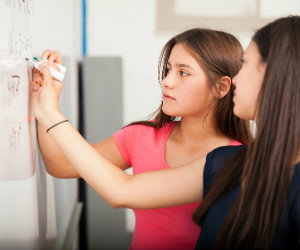Create Viable Co-Teacher Instruction Cycles
A MiddleWeb Blog
 We’re months into the school year, and effective co-teachers are finding what works and what doesn’t work within their personal partnerships. Successful co-teachers make the conscious effort to work together to craft solutions for what’s not working. And then they make it happen.
We’re months into the school year, and effective co-teachers are finding what works and what doesn’t work within their personal partnerships. Successful co-teachers make the conscious effort to work together to craft solutions for what’s not working. And then they make it happen.
This week’s post is about co-creating a successful instructional cycle – no matter what!
Successful co-teachers have found the answer. And it doesn’t matter who the co-teachers are as long as both teachers are somewhat (or completely) open to working together to do what’s right for all learners in the room.
The answer is not too good to be true – it is a surefire way to make the instructional cycle buzz and flow with the excitement of learning. And what is this amazing answer? It’s incorporating a variety of co-teaching models.
First, a quick review
Before we move along to examples of real-life applications, here’s further review of the types of co-teaching models. Take a second to think about what models you have incorporated so far this year and then make a plan to try one more model of co-teaching before the holiday break!
Find a few examples of co-teaching models in these very quick video snippets. If you’d like to deepen your review even more, here’s a refresher on effective co-teaching strategies.

Now we’re ready….
Real teachers – real perspectives – real applications
My district continues to be immersed in ongoing co-teaching professional development through Lakretz Creative Support Services. Most recently, co-teachers experienced a carousel activity led by Casey Stewart.
Since folks in my district have a solid understanding of the co-teaching models, Casey led the group in this activity to guide co-teachers through a discussion of how they have been applying what they know and then reflecting on what works and what needs to be improved.
We looked at four co-teaching models and engaged in collaborative discussions to deepen everyone’s understanding and applications. Here’s the gist:
1. Alternative Teaching
Applications:
Applied during share reading activities with whole class. This model of teaching also works well with math concept review. Students then move to additional small groups for re-teaching and additional practice. Other students work independently while each teacher provides small group instruction.
What works:
-All learners understand the content and skills for the lesson.
-Students are moving around!

-Students may become distracted and self-conscious. So make sure both co-teachers present the small group instruction with positive directives and be sure to alternate students as well as teachers, so it becomes a natural process for all learners.
-Students who are working independently may be struggling, or they may not be working to their full potential. Both teachers must monitor and intermittently walk around to check-in on these students.
2. Team Teaching
Applications:
Math is a wonderful time to incorporate team teaching. Both teachers may work together to guide students toward a deeper understanding of concepts and high expectations.
What works:
The special education teacher becomes knowledgeable of the general education curriculum, and the general education teacher develops a stronger focus on the process and strategies to meet the needs of all learners in the room.
What to watch out for:
There will easily be students in the crowd who may need more direct instruction and re-teaching. Make the time and plan to accommodate them.
3. Parallel Teaching
Applications:
Daily math lessons, reading, or writing lessons are optimal opportunities for parallel teaching! There’s one lesson and two teachers implement it. Simply split the class in half – each teacher provides instruction to that group.

-Teaching half the class makes it easier for teachers to assess in the moment. Students can feel more connected to learning experiences and more at ease to participate.
-It’s a great way to change the setting and routine. Sometimes parallel teaching happens in the same classroom, and sometimes one of the teachers may take their half to another available classroom to lessen any distractions.
-Students love a change of teaching styles.
What to watch out for:
There may be timing and transitioning snafus along the way. One group may accomplish more than the other group. And sometimes teachers may not be on the same page. So make sure to always check in with one another throughout the lesson. And don’t worry if the finished product of the lesson is different in one group. You can figure out a way to review as appropriate. The important thing is to give the students in each group what they need.
As you embed co-teaching models into your lessons, students will transition smoothly and effectively. You both just need to set the stage and give it some time with clear expectations.
4. Station Teaching
Applications:
English Language Arts Stations works well for teachers in my district. Many teachers incorporate these stations three times per week.

What works:
Smaller heterogeneous groups provide more intimate learning and personal student connections. Students feel at ease to respond within the small groups of the station lessons.
-When students are relaxed, they are more enthusiastic, engaged learners.
-Introducing technology is very manageable. Students participate in increased exposure and applications of new technology such as using chromebooks.
What to watch out for:
The students in an independent station may still need support. Check in. Make sure you make directions and goals clear. In addition, make sure that the skills and activities at this independent station are something that students are comfortable to practice and apply.
Have you applied any co-teaching models yet this year? If so, please share! If not, please consider!
What co-teaching questions or connections come to mind? Let’s get a conversation going….

































